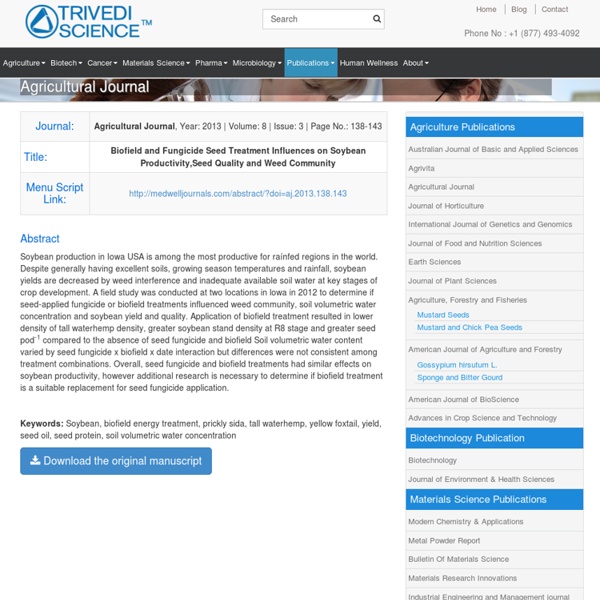Biotyping of Enteropathogenic MDR Escherichia coli Isolates
Description Study background: Multidrug resistant Escherichia coli (MDR E. coli) has become a major health concern, and failure of treatment leads to huge health burden. Aim of the present study was to determine the impact of Mr. Trivedi’s biofield treatment on E. coli.
Research on Escherichia Coli Biochemical Characteristics
Bioeld as an energy medicine has been included in complementary and alternative medicine (CAM) therapies, and very commonly practiced in US by professional healthcare representative [11].
Evaluation of Phenotype and Genotype of Enterobacter Aerogenes
Abstract Enterobacter aerogenes (E. aerogenes) has been commonly described as a versatile opportunistic pathogen in hospital infections. The aim of the present work was to evaluate the impact of biofield treatment on E. aerogenes for its phenotypic and genotypic characteristics. E. aerogenes bearing ATCC 13048 (American Type Culture Collection) was procured from Bangalore Genei, in sealed pack and divided into control and treated groups. Treated group was subjected to Mr. Trivedi’s biofield treatment and analyzed for antimicrobial susceptibility, minimum inhibitory concentration (MIC), biochemical reactions, and biotype using automated MicroScan Walk-Away® system.
Study of Antimicrobial susceptibility of S. Marcescens
Abstract Serratia marcescens (S. marcescens) is Gram-negative bacterium, associated with hospital-acquired infections (HAIs), especially urinary tract and wound infections. The present study was aimed to evaluate the impact of biofield treatment on phenotyping and genotyping characteristics such as antimicrobial susceptibility, biochemical reactions, biotype, DNA polymorphism, and phylogenetic relationship of S. marcescens (ATCC 13880). The lyophilized cells of S. marcescens were divided into three groups (G1, G2, and G3). Control group (G1) and treated groups (G2 and G3) of S. marcescens cells assessed with respect to antimicrobial susceptibility, and biochemical reactions. In addition to that, samples from different groups of S. marcescens were evaluated for DNA polymorphism by Random Amplified Polymorphic DNA (RAPD), and 16S rDNA sequencing in order to establish the phylogenetic relationship of S. marcescens with different bacterial species.
Experimental results of Escherichia Coli Antibiotic Sensitivity Assay
Study background: Multidrug resistant Escherichia coli (MDR E. coli) has become a major health concern, and failure of treatment leads to huge health burden. Aim of the present study was to determine the impact of Mr. Trivedi’s biofield treatment on E. coli. Methods: Four MDR clinical lab isolates (LSs) of E. coli (LS 8, LS 9, LS 10, and LS 11) were taken and divided into two groups i.e. control and biofield treated. Control and treated samples were identified with respect to its antimicrobial sensitivity assay, biochemical study and biotype number using MicroScan Walk-Away® system.
Human Energy Impact on Thermal Properties of DHBP
Citation: Trivedi MK, Tallapragada RM, Branton A, Trivedi D, Nayak G, et al. (2015) Physical, Thermal and Spectral Properties of Bioeld Energy Treated 2,4-Dihydroxybenzophenone. Clin Pharmacol Biopharm 4: 145. doi:10.4172/2167-065X.1000145 Page 8 of 8 Volume 4 • Issue 4 • 1000145 Clin Pharmacol Biopharm
Human Energy Treatment for Increasing Tomato Yield
Abstract: Recent studies report the effect of biofield treatment on changes in structural characteristics of organic and inorganic matter, on cancer cells in vitro and on overall plant development. This study tested the impact of the same treatment applied to lettuce and tomato seeds and transplants (Lactuca sativa var. capitata and Lycopersiconesculentum var.
Multidrug Resistant Isolates of Pseudomonas Aeruginosa
Abstract In recent years, prevalence of multidrug resistance (MDR) in Pseudomonas aeruginosa (P. aeruginosa) has been noticed with high morbidity and mortality. Aim of the present study was to determine the impact of Mr. Trivedi’s biofield treatment on MDR clinical lab isolates (LS) of P. aeruginosa.
Thermal Properties of DHBP after the Human Energy Treatment
Description Study background: 2,4-Dihydroxybenzophenone (DHBP) is an organic compound used for the synthesis of pharmaceutical agents. The objective of this study was to investigate the influence of biofield energy treatment on the physical, thermal and spectral properties of DHBP. The study was performed in two groups (control and treated). The control group remained as untreated, and the treated group received Mr. Trivedi’s biofield energy treatment.
TGA Analysis of Biofield Treated 2,4-Dihydroxybenzophenone
Study background: 2,4-Dihydroxybenzophenone (DHBP) is an organic compound used for the synthesis of pharmaceutical agents. The objective of this study was to investigate the influence of biofield energy treatment on the physical, thermal and spectral properties of DHBP. The study was performed in two groups (control and treated). The control group remained as untreated, and the treated group received Mr.



